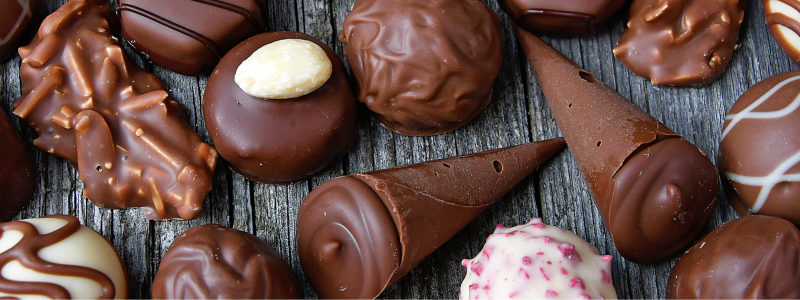
Chocolate, Creativity and Copyright Law: Navigating the Legalities of the Food Industry
In an industry as creative and innovative as food, it’s easy to see why collaboration and inspiration are highly prized. But what happens when inspiration blurs the line into theft? And can a culinary creation ever be copyrighted? We looked into it…
by Lyndsey Hall
13 October 2023
Legalese for (Fizzy) Dummies
Do you know your copyleft from your copyright? How about registered trade marks and patents? Let us take you on a magical mystery tour through the winding legal landscape of the chocolate and confectionery world…
First, let’s take a look at some of the jargon you may come across when navigating the legalities of creativity and business:
- Copyright – In the UK, copyright is automatic upon creating or designing something new. Your original works are protected by copyright without the need to register, you may just need to prove you were the original creator if you’re ever challenged by a competitor, so keep hold of any drafts or notes, and the date they were made!
- Copyleft – You guessed it; copyleft is the opposite of copyright, meaning a creation is free to be used, amended, copied and shared by anyone, as long as they do so ethically and continue to allow the same rights to others.
- Trade mark – Indicated by the abbreviation ‘TM’, trademarked designs are not yet registered, but the creator is asserting their right to associate the design with their brand or business.
- Registered Trade mark – You can pay to register a trade mark on almost anything related to your brand and original designs, i.e. words, sounds, logos, colours, or a combination of these. And you can use the ® symbol to let your competitors know you’re legally protected.
- Patent – More commonly associated with science and engineering, a patent is a type of intellectual property giving exclusive right to the inventor to make, use, sell or distribute the patented product or process (usually for a period of time). So, if you were to invent a newfangled chocolate tempering machine, then you’d probably want to patent it!
Whilst creativity is the beating heart of the culinary world, and the ephemeral nature of food can make it difficult to protect under law, these are a few ways your chocolate creations could be protected – or, unfortunately, infringe upon your competitors’ products. From unique recipes to recognisable designs, and even the storytelling behind products, there are legal methods of preserving your creativity and protecting your original creations.
Applying Copyright Law to Food – a Unique (but Delicious) Challenge
Copyright law forms the backbone of intellectual property protection, ensuring creators have exclusive rights to their original work. It’s commonly associated with art, literature and music, but it also extends to food. Whilst it doesn’t apply to intangible ideas or concepts, it can be applied to the expression of those creative ideas in a tangible form, e.g. a specific recipe, unique combination of ingredients or method of preparation. In order to protect your unique creation, it can be helpful to document the recipe and process behind it, whether that be through written recipes, cookbooks, or even video demonstrations.
Alternatively, you could keep the recipe a closely guarded secret, to maintain exclusivity and prevent others from replicating the dish. You’ll have come across this ‘secret recipe’ tactic when ordering a bucket of ‘finger-licking good’™ fried chicken.
In addition, you could trade mark your brand identity, logo, business name and unique product names. Combining these strategies can help food creators to protect their original recipes and prove infringement, in the event a competitor does the unthinkable and copies your chocolate designs.
Now, let’s check out some examples of confectionery copyright issues…
Colin versus Cuthbert: The Case of the Copyrighted Caterpillar
David and Goliath. Rocky and Apollo. Colin and Cuthbert. Three of the most iconic conflicts in history, but who won the battle of the butterfly larva confection?
In 2021, M&S announced a lawsuit against fellow retail giant Aldi, over the sale of caterpillar celebration cakes. Whilst every supermarket chain has their own version of the classic caterpillar cake, Marks & Spencer have registered three trade marks relating to Colin, and their intellectual property claim against Aldi argued that the product was too similar, leading customers to believe they were the same product, or of the same quality. The two retailers eventually came to a ‘confidential agreement’ in 2022 (after a much—publicised social media war), which allowed Aldi to continue selling Cuthbert, with a few minor alterations.
What’s in a Name? Pig Mugs, Perky Pig and Henry Hippo
Another flagship product from M&S is the famous, grape-flavoured gummy, Percy Pig. But, like Colin, Percy isn’t the only pig in town.
Swizzels, the Refreshers, Parma Violets and Drumsticks sweetmaker, have sold a very similar porcine sweet named Pig Mugs since 1996 – just four years after the launch of M&S’s Percy Pigs. In 2022, M&S threatened to take Derbyshire-based Swizzels to court over the infringement of its registered trademark and ultimately reached an ‘amicable resolution’, with Swizzels agreeing to change the design of their pig sweets.
In 2023, a family-run ice cream parlour in Hitchin, Fabio’s, received a cease-and-desist letter from M&S asking them to change the name of their ‘Perky Pig’ ice cream, which used the brand’s Percy Pig sweets as decoration. Hoping to resolve the disagreement civilly, the supermarket giant stated they were welcome to continue using the sweets, but suggested some alternative names for the ice cream flavour, as they needed to protect their trade mark. This prompted the gelato maker to run a competition to choose a new name, and rebrand the ice cream ‘Notorious P.I.G.’.
But, before long, another supermarket jumped at the chance to get involved.
Lidl sent a handwritten letter and a parcel of their own grape gummies, Henry Hippos, to Fabio’s, and suggested the gelateria could rename the flavour ‘Henry Hippo’ ice cream, and use their pink sweets on top instead.
Problematic Packaging and Presentation
It’s not just the food products themselves that can cause legal problems, the packaging design can also raise concerns, particularly where brand colours are protected by a registered trade mark. For instance, one of the trade marks held by M&S with relation to Colin the Caterpillar is specifically connected to the way the packaging is presented, and this formed a key part of the case against Cuthbert.
In another case brought by M&S against Aldi, the retail rivals disagreed over the sale of gold-flake gins in illuminated bottles. Eventually, the judge ruled that Aldi’s Infusionist gins were too similar to M&S’s original Snow Globe bottles, and therefore infringed upon the registered trade marks held by M&S. The dispute had nothing to do with the flavours or recipes of the drinks contained in the bottles, and solely focused on the way the gins were presented in almost identical bottles.
The takeaway here is that your chocolate business needs unique branding if you want to stand out, and that taking inspiration from a competitor is fine, as long as you don’t try to replicate their products or presentation exactly. No one likes a copycat, and you could end up with a penalty or sky-high legal fees.
We hope that’s demystified some of the confusion around copyrights, trade marks and food products. As chocolatiers, we’re not legal experts so it’s always best to get professional advice when needed, but now you can go forth and create, safe in the knowledge that your innovative chocolate designs are protected under copyright law!
Got a taste for the legal side of chocolate now? Take a look at our guides to Food Labelling Requirements and Regulations Governing the Production and Packaging of Chocolate Products, for a little light reading!

Lyndsey is a marketing executive, writer and lover of books and chocolate from Sheffield.
Her favourite chocolate is Cacao Barry Lactee Superieure.